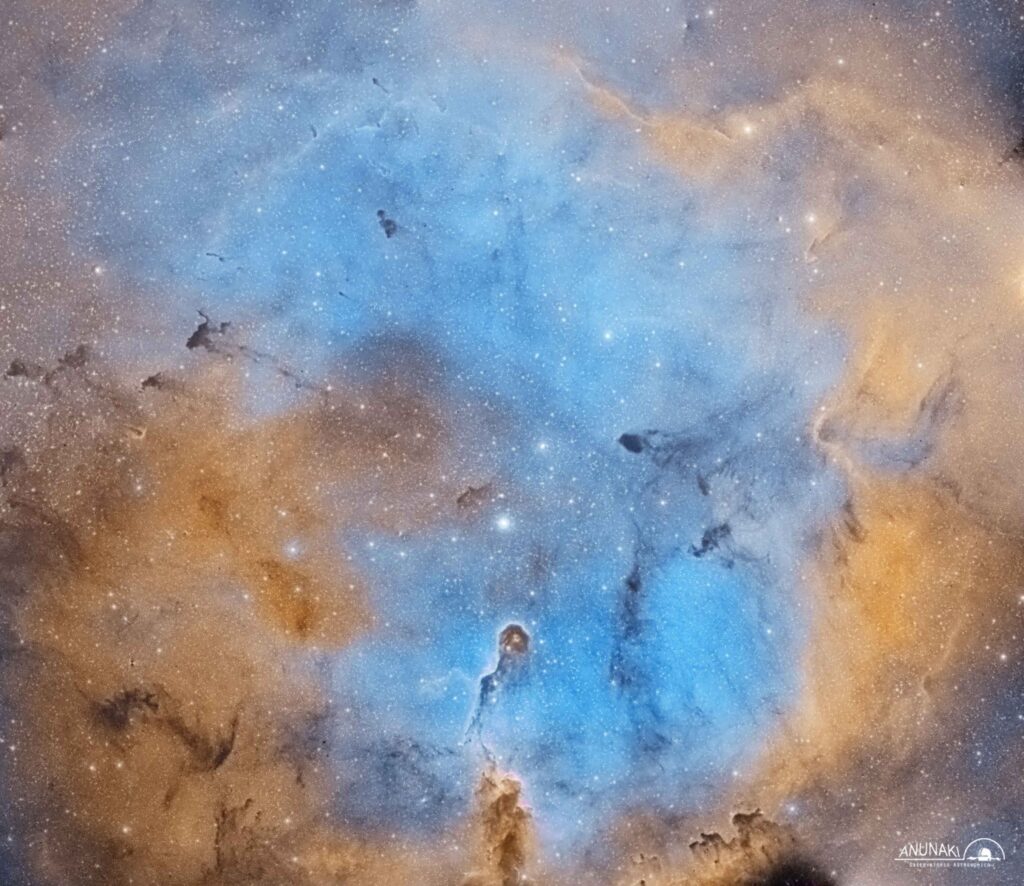The Elephant Trunk Nebula comprises the emission nebula and the cluster of young stars IC 1396, in the high and distant constellation of Cepheus.
Bright ripples make up the subjective form, contouring pockets of interstellar dust and gas.
These types of dark comet-shaped clouds contain the basic material for star formation. About 3,000 light-years away, the relatively faint set of IC1396 encompasses a much longer region of the sky than shown here, with an apparent amplitude of more than 10 moons.
The image obtained highlights the retrotracted shape of the ridges that contour the pockets of gas and cold interstellar dust.

Technical data:
Telescope: SkyWatcher ED80
CCD:Atik314L+
Focal Length Reducer: SW 0.8x
Filters: Ha 12nm
Telescope Guide: S/C 203mm
Mount: LX200 GPSR
Guide CCD: QHY5
CCD Temp:-5º
Ambient Temp:20º/19º
Location: Anunaki Observatory / Rivas Vaciamadrid (Madrid)
These dark clouds, immersed in the nebula and shaped like tendrils, contain the raw material for star formation and hide proto-stars inside the opaque cosmic dust.
Twisted filaments of infrared emissions stretch over 12 light-years, due to dust, molecular hydrogen and complex molecules called polycyclic aromatic hydrocarbons or PAHs.
Infrared images near the IC 1396-N cumulus, as well as with HII narrowband filter and the use of J, H, and K band filters. Proto-stars were detected within the cumulus, with different luminosities. Most of the knots are associated with high-speed PEAKS of CO emission, indicating that they trace shocked regions along nearby stellar jets.

Technical data:
Telescope: SkyWatcher ED80
CCD:Atik314L+
Focal Length Reducer: SW 0.8x
Filters: Ha 12nm/O[III] 12nm/S[II] 12nm
Telescope Guide: S/C 203mm
Mount: LX200 GPSR
Guide CCD: QHY5
CCD Temp:-5º
Ambient Temp:20º/19º
Location: Anunaki Observatory / Rivas Vaciamadrid (Madrid)
From the morphology and orientation of the H2 knots, we identified at least three different sources: one of them is shocked by the young proto-star associated with IRAS 21391 5802, which represents the most luminous object in the region, while we were able to identify only one of the other two sources of conduction by means of near-infrared photometry.
Photometry reveals the existence of a set of young embedded sources located on a north-south line that follows the distribution of high-density gas and testifies to very efficient star-forming activity across the entire globule. Based on observations collected with the AZT-24 Imperatore Field Telescope.

Technical data:
Telescope: SkyWatcher ED80
CCD:Atik314L+
Focal Length Reducer: SW 0.8x
Filters: Ha 12nm/O[III] 12nm/S[II] 12nm
Telescope Guide: S/C 203mm
Mount: LX200 GPSR
Guide CCD: QHY5
CCD Temp:-5º
Ambient Temp:20º/19º
Location: Anunaki Observatory / Rivas Vaciamadrid (Madrid)
Through the use of different narrowband filters and the application of the Hubble palette (SHO), I obtained this image that transports us to a place of reverie and creation of new worlds and consequently new life.
